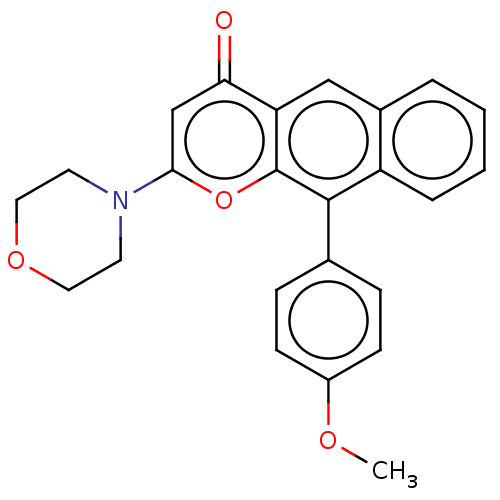BDBM50200519 CHEMBL3915703
SMILES COc1ccc(cc1)-c1c2ccccc2cc2c1oc(cc2=O)N1CCOCC1
InChI Key InChIKey=IQUGIKIYSFPJHS-UHFFFAOYSA-N
Data 4 IC50
Activity Spreadsheet -- Enzyme Inhibition Constant Data from BindingDB
 Found 4 hits for monomerid = 50200519
Found 4 hits for monomerid = 50200519
TargetPhosphatidylinositol 4,5-bisphosphate 3-kinase catalytic subunit delta isoform(Homo sapiens (Human))
La Trobe University
Curated by ChEMBL
La Trobe University
Curated by ChEMBL
Affinity DataIC50: 5.60E+3nMAssay Description:Inhibition of p110delta (unknown origin) assessed as decrease in ATP consumption after 60 mins by Kinase-Glo assayMore data for this Ligand-Target Pair
TargetPhosphatidylinositol 4,5-bisphosphate 3-kinase catalytic subunit gamma isoform(Homo sapiens (Human))
La Trobe University
Curated by ChEMBL
La Trobe University
Curated by ChEMBL
Affinity DataIC50: >5.00E+4nMAssay Description:Inhibition of p110gamma (unknown origin) assessed as decrease in ATP consumption after 60 mins by Kinase-Glo assayMore data for this Ligand-Target Pair
TargetPhosphatidylinositol 4,5-bisphosphate 3-kinase catalytic subunit beta isoform(Homo sapiens (Human))
La Trobe University
Curated by ChEMBL
La Trobe University
Curated by ChEMBL
Affinity DataIC50: >5.00E+4nMAssay Description:Inhibition of p110beta (unknown origin) assessed as decrease in ATP consumption after 60 mins by Kinase-Glo assayMore data for this Ligand-Target Pair
TargetPhosphatidylinositol 4,5-bisphosphate 3-kinase catalytic subunit alpha isoform(Homo sapiens (Human))
La Trobe University
Curated by ChEMBL
La Trobe University
Curated by ChEMBL
Affinity DataIC50: >5.00E+4nMAssay Description:Inhibition of p110alpha (unknown origin) assessed as decrease in ATP consumption after 60 mins by Kinase-Glo assayMore data for this Ligand-Target Pair
